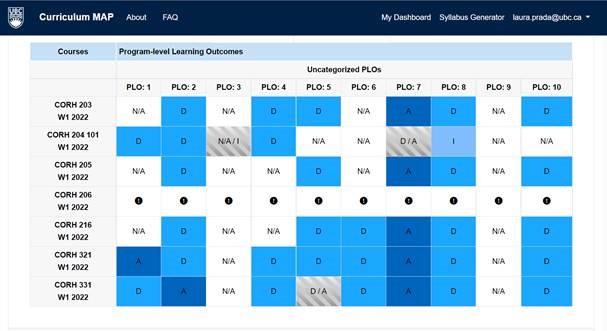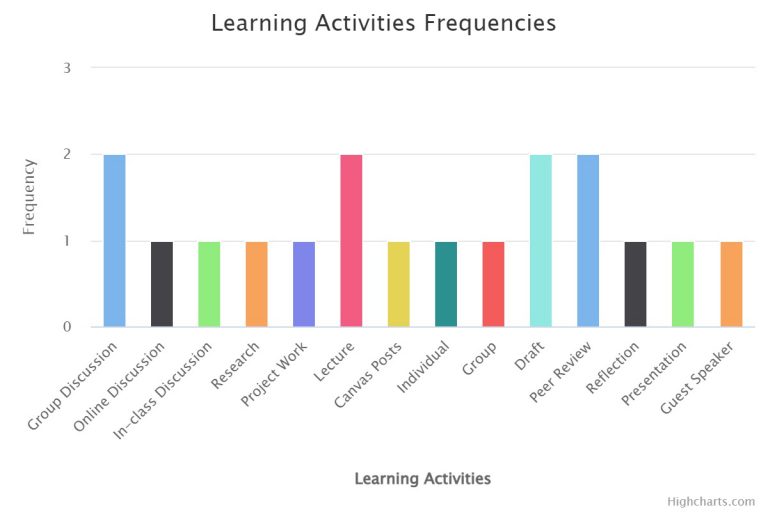As part of the ALT funded project to create a certificate and minor in Communications and Rhetoric, Dr. Anita Chaudhuri joined a discussion with the Provost’s office here at UBCO to find out what kind of supports were available for program development. That sparked a conversation with Dr. Bowen Hui and Janine Hirtz about tools to help streamline the process of program and course development.
Laura Prada explains that in the Office of the Provost and Vice-President Academic, they were looking at ways to support faculty members to create and evaluate programs from a learning outcomes perspective which is a pillar of high-quality education towards student success.
“There was excitement to do something that was thoughtful, intentional and supported by pedagogical best practices,” she says.
So a team was created with faculty members, staff from the Office of the Provost and the Centre for Teaching and Learning (CTL), and the Centre for Teaching, Learning and Technology (CTLT), along with co-op students to help build the Curriculum MAP platform that would assist with mapping, alignment and planning of courses and programs and support instructors in creating course syllabi consistent with our Senate guidelines.
The CTL and the CTLT support faculty in developing curriculum for new courses, redesigning current courses or with new programs.
Janine Hirtz, Manager and Senior Education Consultant with the CTL explains that when working with faculty, they look at ways to align curriculum learning outcomes with program and institutional goals around things like the Indigenous Strategic Plan and Inclusion Action Plan.
“The more faculty can show collaboration with interdisciplinary ways or foster goals of university and programs, they are more likely to have better success,” she says.
This team has now been working on the Curriculum MAP project for the last two years, and the platform is ready and available for use. The tool supports a step-by-step process with links to resources that will help identify learning outcomes, principals of universal design for learning to support inclusive learning design as well as a syllabus generator.
For their ALT funded project, World Literatures and Intercultural Communication’s team has used the Curriculum MAP tool to develop a major and minor. They will include the reports generated by the tool in their package for the Ministry of Advanced Education and Skills Training.
Dr. Chaudhuri says she was motivated to be part of this development with a desire to understand how courses across campus approach learning objectives and how we prepare students for their academic and professional lives.
She notes that this tool can also help us identify gaps, for instance, if assessment practices and classroom activities align with the course objectives, and visualize how program level outcomes relate with strategic priorities of the institution.
This online tool provides flexibility to meet the needs of faculty in any point of their development to generate ideas, create, and evaluate new or existing courses and programs, using backward design.
With this tool, the goal is to get to a point where instructors feel they are supported with curriculum development without having to know the ins and outs of pedagogical needs, or of specific program requirements.
“The website will meet the needs of instructors at different points – if they want to identifying learning outcomes, or figure out how to align assessment strategies, or how are they meeting the TRC Calls to Action or sustainability commitments for the university,” says Prada.
Hirtz adds that they want to see faculty use this to generate syllabus to make the planning process more streamlined in finding statements and policies that are needed on an outline. “On a student level, it would be great to have something standardized that is similar across faculties and departments.”
The following are examples of some of the Curriculum MAP outputs.

Table generated by the Curriculum MAP tool, showing how courses align with program learning outcomes
Please note these are not accurate representation of CORH courses.
Meet the Team
The Curriculum MAP working group consists of Dr. Anita Chaudhuri (Department of English and Cultural Studies); Dr. Bowen Hui (Department of Computer Science); Janine Hirtz (Manager and Senior Educational Consultant, CTL); Carrie Hunter (Curriculum Consultant, CTL); Laura Prada (Office of the Provost); Abdelmuizz Yusuf (Undergraduate Developer); Jia Fei LuoZheng (Undergraduate Developer); Damyn Filipuzzi (Undergraduate Developer); Daulton Baird (Undergraduate Developer); Kieran Adams (Undergraduate Developer).
